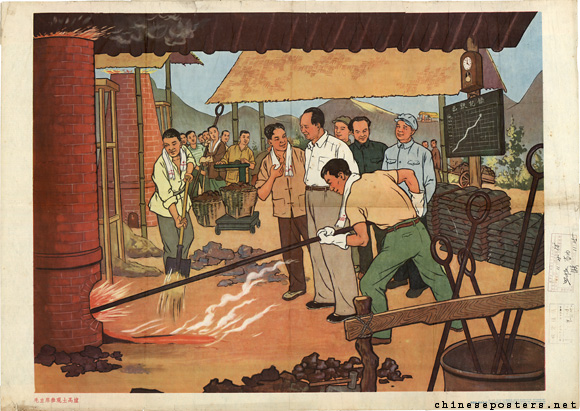More languages
More actions
No edit summary Tag: Visual edit |
(Hyperlink) Tags: mobile web edit mobile edit advanced mobile edit |
||
| Line 1: | Line 1: | ||
[[File:Great Leap Forward poster.png|thumb|Poster of [[Mao Zedong|Mao]] visiting a homemade steel furnace during the Great Leap Forward]] | [[File:Great Leap Forward poster.png|thumb|Poster of [[Mao Zedong|Mao]] visiting a homemade steel furnace during the Great Leap Forward]] | ||
The '''Great Leap Forward''' (大跃进) was an economic and social campaign in China during the [[Five-year plans of China#Second Plan (1958–1962)|Second Five-Year Plan]]. During the Great Leap Forward, [[Peasantry|peasants]], who had already [[Collectivization|collectivized]] land, joined large communes of thousands of people. They tried to produce steel in small rural foundries, also known as backyard steel furnaces. Mao admitted that policy errors occurred and took responsibility for them, but [[Imperial core|Western]] claims of mass starvation are widely exaggerated.<ref name=":0">{{Web citation|author=Joseph Ball|newspaper=[[Monthly Review]]|title=Did Mao Really Kill Millions in the Great Leap Forward?|date=2006-09-21|url=https://mronline.org/2006/09/21/did-mao-really-kill-millions-in-the-great-leap-forward|archive-url=https://web.archive.org/web/20230109091835/https://mronline.org/2006/09/21/did-mao-really-kill-millions-in-the-great-leap-forward|archive-date=2023-01-09|retrieved=2023-02-07}}</ref> | The '''Great Leap Forward''' (大跃进) was an economic and social campaign in China during the [[Five-year plans of China#Second Plan (1958–1962)|Second Five-Year Plan]]. During the Great Leap Forward, [[Peasantry|peasants]], who had already [[Collectivization|collectivized]] land, joined large communes of thousands of people. They tried to produce steel in small rural foundries, also known as [[backyard furnace|backyard steel furnaces]]. Mao admitted that policy errors occurred and took responsibility for them, but [[Imperial core|Western]] claims of mass starvation are widely exaggerated.<ref name=":0">{{Web citation|author=Joseph Ball|newspaper=[[Monthly Review]]|title=Did Mao Really Kill Millions in the Great Leap Forward?|date=2006-09-21|url=https://mronline.org/2006/09/21/did-mao-really-kill-millions-in-the-great-leap-forward|archive-url=https://web.archive.org/web/20230109091835/https://mronline.org/2006/09/21/did-mao-really-kill-millions-in-the-great-leap-forward|archive-date=2023-01-09|retrieved=2023-02-07}}</ref> | ||
== Famine == | == Famine == | ||
Revision as of 08:34, 10 April 2023

The Great Leap Forward (大跃进) was an economic and social campaign in China during the Second Five-Year Plan. During the Great Leap Forward, peasants, who had already collectivized land, joined large communes of thousands of people. They tried to produce steel in small rural foundries, also known as backyard steel furnaces. Mao admitted that policy errors occurred and took responsibility for them, but Western claims of mass starvation are widely exaggerated.[1]
Famine
Western sources often claim that the largest famine in history took place during the Great Leap Forward. Official Chinese documents released after Mao's death put the death toll at 16.5 million, which may be exaggerated, while bourgeois sources claim that 30 or even 38 million people died. In actuality, Mao increased China's life expectancy by 30 years and increased food production by 169.6%.[1]
References
- ↑ 1.0 1.1 Joseph Ball (2006-09-21). "Did Mao Really Kill Millions in the Great Leap Forward?" Monthly Review. Archived from the original on 2023-01-09. Retrieved 2023-02-07.
